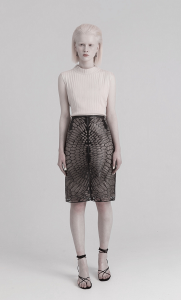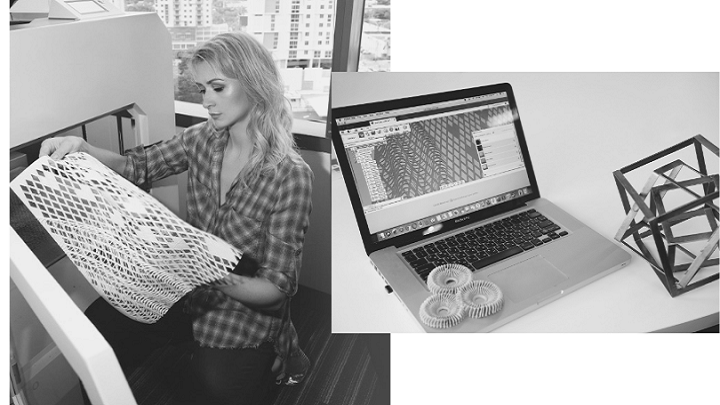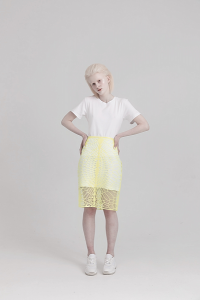 3D printing is moving ever closer to gaining a true home in mainstream commercial applications, thanks to the impact the technology is having on consumer fashion products such as jewelry, footwear, and clothing. While 3D printed fashion was still considered to be more of a novelty a few years ago, efforts have been increasing to make it more common – even in the classroom. Additionally, the technology is helping to usher in a more sustainable and eco-friendly way of manufacturing garments…and designer Julia Daviy is helping to lead the charge.
3D printing is moving ever closer to gaining a true home in mainstream commercial applications, thanks to the impact the technology is having on consumer fashion products such as jewelry, footwear, and clothing. While 3D printed fashion was still considered to be more of a novelty a few years ago, efforts have been increasing to make it more common – even in the classroom. Additionally, the technology is helping to usher in a more sustainable and eco-friendly way of manufacturing garments…and designer Julia Daviy is helping to lead the charge.
In addition to designing clothes, Daviy is also an ecologist and clean technology industry manager, and uses 3D printing to make cruelty-free, zero-waste clothing. She believes that the technology will change how the world produces clothing, especially when it comes to some of the more problematic issues of garment manufacturing, such as animal exploitation, chemical pollution, energy consumption, and material waste.
“Our goal was never to demonstrate the viability of 3D printed clothing and leave things at that. We’ll have succeeded when beautiful, comfortable, ethically manufactured and environmentally friendly clothes are the standard,” Daviy stated. “The innovations we’ve made on the production and marketing side of the equation are just as important as the technological breakthroughs that have gotten us this far.”
Concerned with the economically and environmentally irresponsible ways most clothes are made, she created an activewear line made with organic fabrics, and went on to study 3D printing at the University of Illinois in an attempt to find a better, “more complete alternative.” Daviy created her first wearable, 3D printed piece in 2017, and continued working to grow her knowledge base. She experimented with multiple 3D printing techniques, like FDM and SLA, and spent time working with manufacturers on various filament specifications.
At New York Fashion Week in September, Daviy released the first 3D printed, functional, women’s fashion collection in the US that uses large-format 3D printing. While I wouldn’t have called most of the pieces in that collection appropriate for everyday use, all of them, like the Pure Nature Suit, definitely looked wearable. But now the pioneering designer has come out with something that I would definitely classify as a functional garment: what she’s calling the first digitally customizable, widely available 3D printed skirt.
The skirt is environmentally friendly, made with ethical manufacturing, and can be custom designed and purchased on Daviy’s website so it fits the size and personality of the customer. The 3D printed, digitally customizable skirt meets, according to the website, “your highest sustainable and technological expectations.”
“This is a truly sustainable, zero-waste skirt that was designed and produced in the USA using groundbreaking technology invented and patented by Julia Daviy. This method allows Daviy to 3D print clothing with less than 1% of waste in the clothing production process,” the website reads.
“The skirt is produced by combining innovative 3D printing practices with fabric linings and luxury trimmings that meet the highest environmental and ethical standards.”
Customers can choose almost everything about the skirt, from its color and style down to the waistline. Then, Daviy and her team create a digital model of the skirt using this information, and fabricate it on a large-scale 3D printer, using Daviy’s patented, zero-waste process, out of recyclable TPE material; the organic, stretchable lining is 5% Lycra and 95% silk.
I went to the website to design my own skirt, which is typically delivered in ten days’ time, though you can choose faster delivery options. The only pattern choice is organic, but there are three styles to choose from: mini, A-line, and pencil. You can select a high or short waist wrap, or none at all, and you can also choose to add pockets (yes, pockets! Pause for a moment of celebration!). Color choices are black, blue, white, nude, and yellow, and the lining can be black, white, or nude.
“You are unique,” the website states. “Wear a garment that reflects your identity.”
The skirt is designed for a slightly loose fit, and should be hand washed separately in cold water and dried flat; it should not be ironed.
Based on looks alone, I would wear multiple versions of this cute skirt anywhere. But, as to be expected with customizable products, the more things you add on, the higher the price tag goes. A mini skirt with no waist wrap and no pockets is already breaking the bank for me at $780, and when I designed an A-line skirt with a short waist wrap and pockets, the price shot up to $1,350. But again, customized garments anywhere don’t come cheap, and at least you can sleep tight knowing that Daviy’s zero-waste pieces are more eco-friendly.
“I started to experiment with 3D printing because I believe that in an age of radical change and global challenges, people need absolutely new clothing. The first stage is to simplify digital customization and 3D printing of flexible and wearable clothing. We’ve accomplished that, and I think that consumers will respond,” Daviy said. “Once we’ve brought this technology into the mainstream, we plan to use 3D printing to make smart clothing that integrates technology even further into the design and function of our collection.”
Discuss this story and other 3D printing topics at 3DPrintBoard.com or share your thoughts in the Facebook comments below.
[Images: Julia Daviy]
Subscribe to Our Email Newsletter
Stay up-to-date on all the latest news from the 3D printing industry and receive information and offers from third party vendors.
Print Services
Upload your 3D Models and get them printed quickly and efficiently.
You May Also Like
The Market and Industry Potential of Multi-Material 3D and 4D Printing in Additive Electronics
Additive manufacturing leverages computer-based software to create components for products by depositing either dielectric or conductive materials, layer by layer, into different geometric shapes. Since its birth in the 1980s,...
3DPOD 262: Bio-inspired Design for AM with Dhruv Bhate, Arizona State University
Dhruv Bhate is an associate professor at Arizona State University. There, he looks at structures, materials, and design. Previously, he worked at PADT as well as in the semiconductor and...
3DPOD 261: Tooling and Cooling for AM with Jason Murphy, NXC MFG
Jason Murphy´s NXC MFG (Next Chapter Manufacturing) is not a generalist service; instead, the company specializes in making tooling. Using LPBF and binder jet, the company produces some of the...
3DPOD 260: John Hart on VulcanForms, MIT, Desktop Metal and More
John Hart is a Professor at MIT; he´s also the director of the Laboratory for Manufacturing and Productivity as well as the director of the Center for Advanced Production Technologies....



































